Ericailcane at Galleria Patricia Armocida in Milan
Posted in: Uncategorized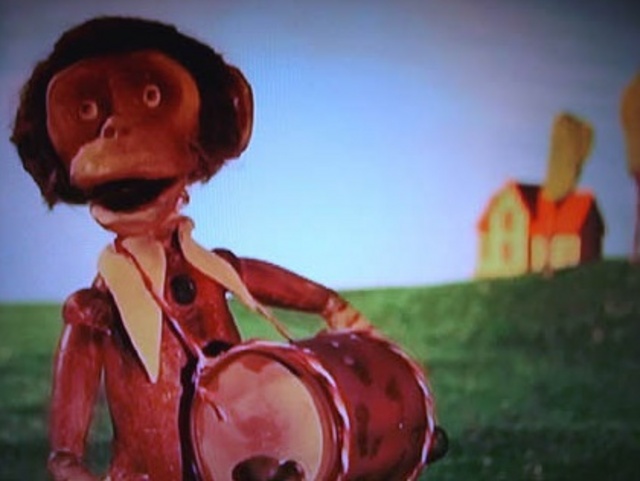

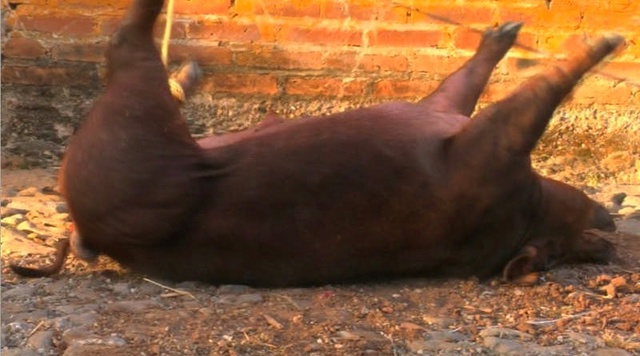
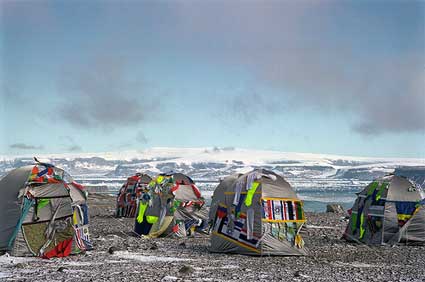
Lucy + Jorge Orta | Antarctic Village – No Borders, 2007, courtesy Galleria Continua, San Gimignano – Beijing. Photo: JJ Crance
According to the Antarctic Treaty signed in 1959, the continent’s territory is a protected ecosystem and as such cannot be used neither for military purposes nor commercial exploitation. The Antarctic contains 70% of the planet’s fresh water reserves in the form of ice and, today, its name evokes the slow melting of the ice caused by global warming. In 2007 Lucy + Jorge Orta went to the inhospitable land on an artistic and social research expedition.
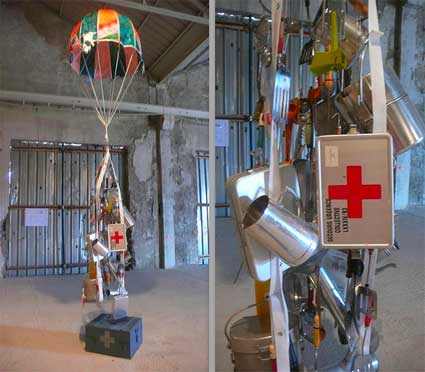
Antarctic Village – No Borders, Drop Parachute
The tents, survival kits, videos and mobile aid units created by the artists as a result of their expedition to the edge of the world are having their first public showing at the Hangar Bicocca in Milan. Hangar Bicocca is real big. Before being a space dedicated to contemporary art, it was a vast industrial factory that manufactured bobbins for electric train motors.
The star of the exhibition is Antarctic Village. Made of 50 dwellings that bring out the images of refugee camps broadcast on tv, the installation is a symbol of the plight of those struggling to cross borders and to gain the freedom of movement necessary to escape political and social conflict. The temporary encampment was envisioned as a free, neutral territory in a place where living conditions are so extreme that it imposes a situation of mutual aid and solidarity, no matter your nationality.
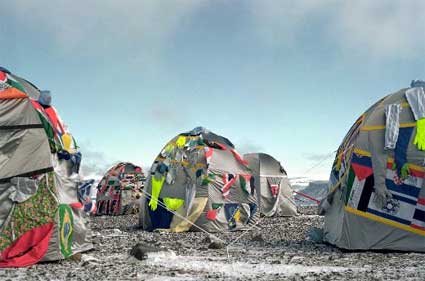
The tents are hand stitched with sections of flags from around the world, along with clothes and gloves, symbolising the multiplicity and diversity of people. A recent UN source states that 2.2 million migrants, mainly from the African and Asian continents, will arrive in the rich world every year from now until 2050. The artists go beyond their comment on the free circulation of individuals across the whole planet by proposing an amendment to the Universal Declaration of Human Right that would include the right to free circulation, on par with merchandise, economic flows and pollution.
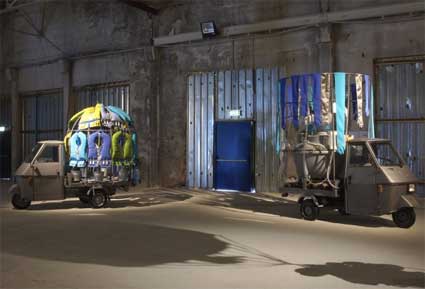
Photo Credit: Thierry Bal Photography
The Antarctica exhibition is also an occasion for presenting other works created by the couple over the last five years, addressing social, environmental and humanitarian issues: mobility, migration, climate and environmental crises, and human rights:
– Orta Water, everyday objects and mobile prototypes which allow for water gathering, purification and distribution. They were designed for the part of the world population whose access to food and water is put at risk by the consequences of environmental crisis and free market privatization.
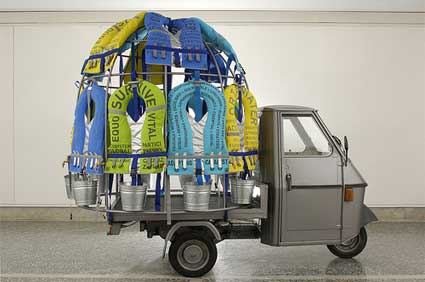
Orta Water – Urban intervention unit, 2005. Credit Photo, Gino Gabrielli
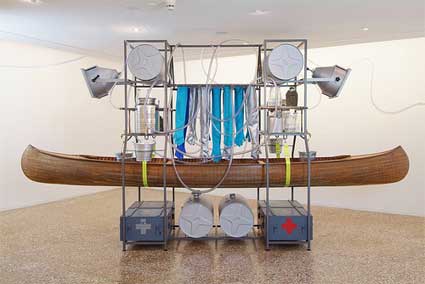
Orta Water – Mobile intervention unit. Photo credit: Gino Gabrieli
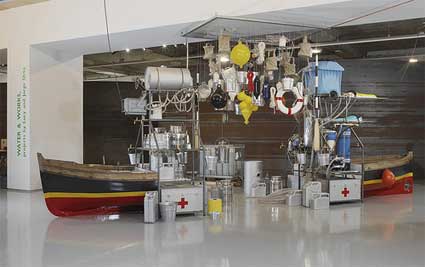
Orta Water – Purification station. Photo credit: Bob Goedewaagen
– Urban Life Guard, the famous series of survival figures created by the artists for their urban performances. The structure is made of stretchers, camp beds, resistant garments and modular devices, which, in case of situation of crisis or danger, can be assembled and used as sleeping bags or shelters.
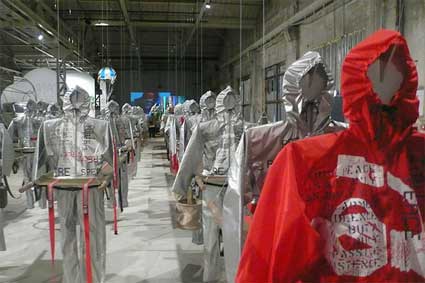
– some M.I.U. (Mobile Intervention Unit): industrial, ex-army vehicles or ambulances converted into first aid units for civilian populations. They are outfitted with an array of emergency equipment that range from water filtering systems to temporary dormitories. On the exterior, quotations, sentences or images recall the fate of those who are forced to immigrate for survival. Stationed at hangar Bicocca was Nomad Hotel, a reconditioned military four-wheel truck with micro living quarters and a transformed Red Cross ambulance, from which visitors can claim their Antarctic World Passport, created by the artists to offer a symbolic access to all the countries in the world.
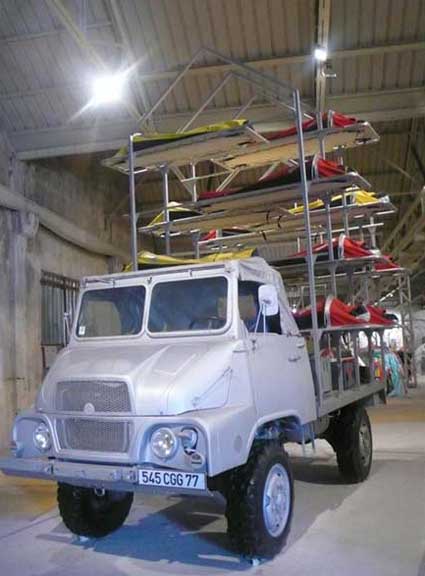
M.I.U. VII – Nomad Hotel, 2003
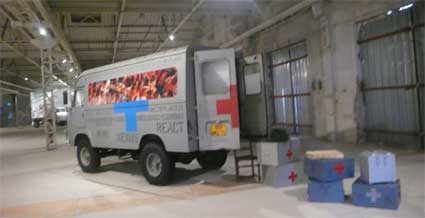
M.I.U. (Mobile Intervention Unit) ambulance
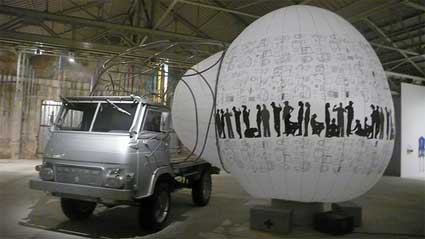
Dwelling X
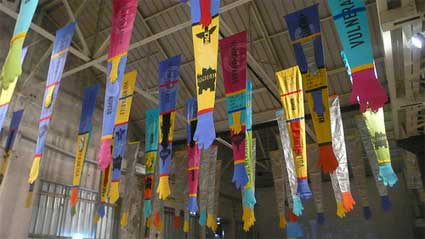
Ornaments of Suffering, 2005
Among the new works which have been commissioned for the Milan exhibition is a fascinating and poetic wall installation of life jackets Life Line.
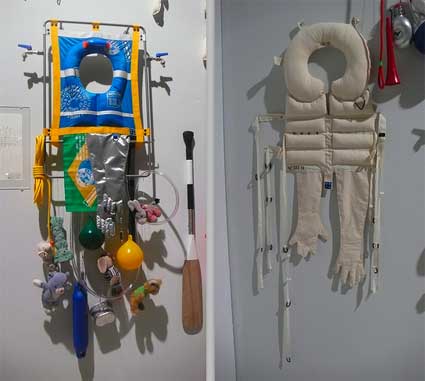
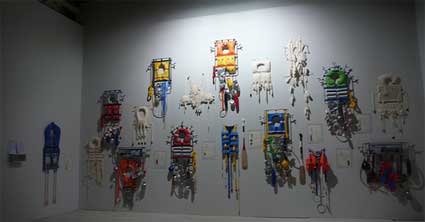
Lucy + Jorge Orta | Life Life – Survival Kit, 2008
My flickr set.
Lucy + Jorge Orta’s Antarctica expedition is on view at Hangar Bicocca in Milan until June 8, 2008.
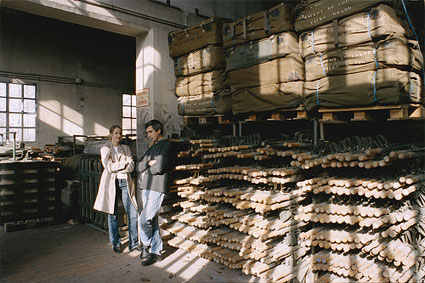
Portrait of Lucy and Jorge Orta
There are very very few artists whose work i admire as much as Nathalie Djurberg’s. Actually there’s only one and she’s a woman too. Her name is GabrÃela Fridriksdóttir. These artists create universes which are dark and mysterious. But there stops my desire to compare one with the other.
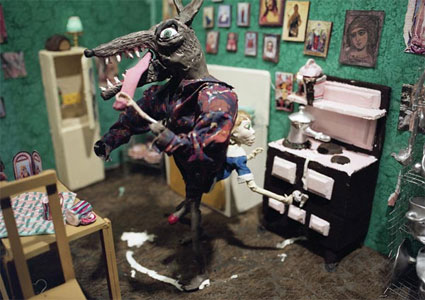
Nathalie Djurberg, We are not two, we are one, 2008
I don’t know what happened to Djurberg since the first time i saw her work, at the 2006 Berlin Biennale but her twisted tales have grown crueler and more menacing .
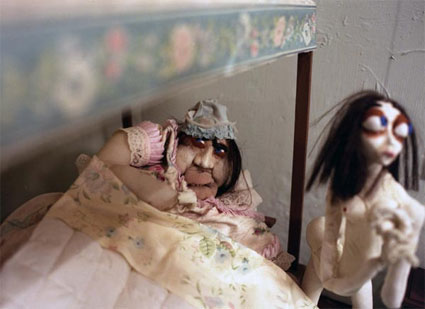
Nathalie Djurberg, Once removed on my mother’s side, 2008
The protagonists of Djurberg’s stop-motion animations are hand-modeled plasticine puppets. If this reminds you of some cute tv programme you followed as a kid then let me crush any nostalgia you might have. Djurberg clearly didn’t see the same children animations as you and i. Her animations show human beings at their most crass, psychopath, sadistic and often disarming behaviour. The macabre atmosphere of her animations almost never come with words, just a languid and fidgety music composed by Hans Berg.
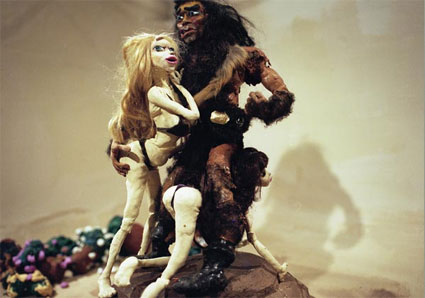
Nathalie Djurberg, Caveman Mike, 2008
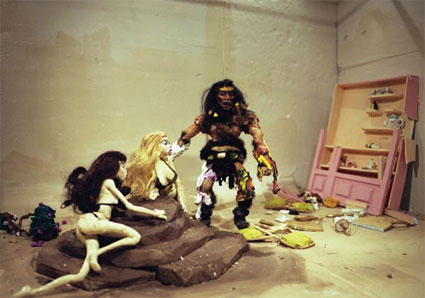
Nathalie Djurberg, Caveman Mike, 2008
It often starts well. In one video, a mother plays in the bedroom with her kids. In a second video, three beautiful girls get naked to take a bath in the pond. A third film shows a pretty eskimo girl walking on thick ice. After a few seconds, the children start disappearing inside their mummy’s vagina turning her voluptuous, elastic and Fellini-esque body into a monster creature with multiple arms and legs, the girls chase and burn the young lad who was peeping at their nudity and the eskimo does what any eskimo is supposed to do: she harpoons a walrus, remove its bowels. Only that she won’t eat it. She sews herself inside the animal’s skin and quietly leaves for a crawl on the icefield.
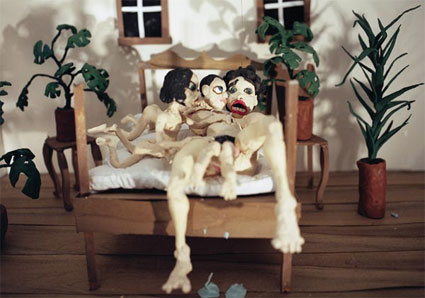
Nathalie Djurberg, It’s the mother, 2008
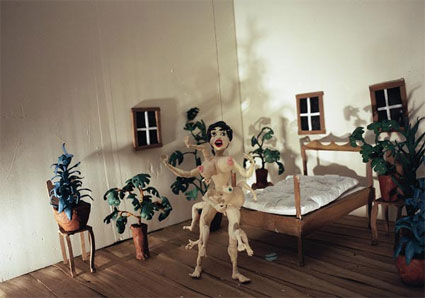
Nathalie Djurberg, It’s the mother, 2008
The videos address a fair amount of intense issues such as violence, sexuality, sadism, cruelty, death and brutality. Made all the more upsetting by the fact that the artist messes with our moral codes and would never point to us where is the right and where is the wrong. She takes us on a roller-coaster and all we can to is try and keep track of our landmarks.
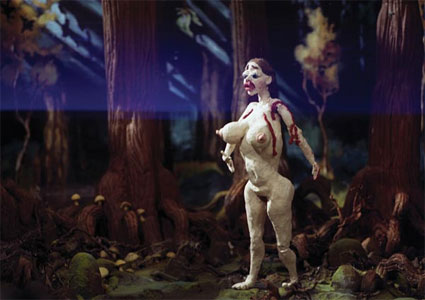
Nathalie Djurberg, Turn into me, 2008
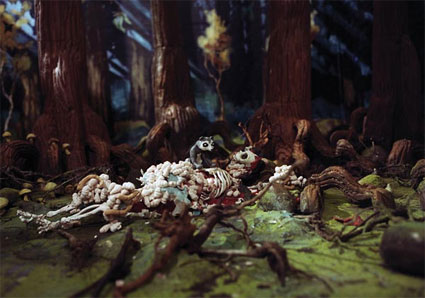
Nathalie Djurberg, Turn into me, 2008
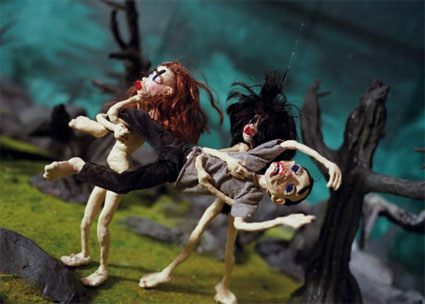
Nathalie Djurberg, Johnnny, 2008
The artists filled the exhibiting space of Fondazione Prada with models that work as counterparts to her videos, there’s a huge sprouting potato, the plump bum of a woman, a little house . These models become pavilions inside which the videos are projected.
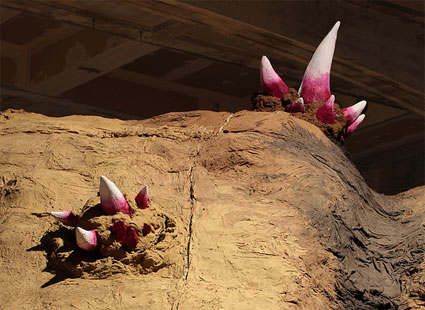
The Potato (detail). Photo Attilio Maranzano
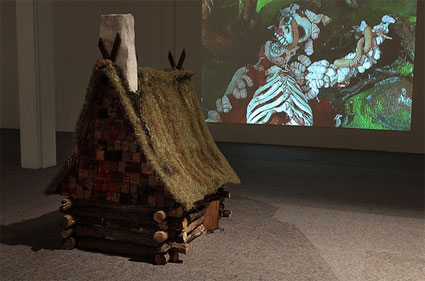
Das Waldhaeuschen, 2008. Photo Attilio Maranzano
You have until June 1 to check out the show. Previously at the Fondazione Prada in Milan: Tom Sachs.
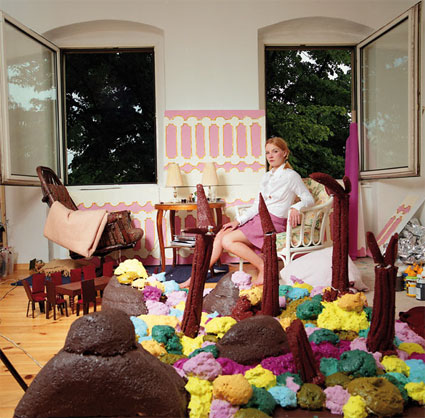
Portrait of Nathalie Djurberg. Photo by Hans Berg
All images courtesy of the artist and Fondazione Prada, Milan.
There’s something about Second Life that totally repels me: its aesthetics. No matter how sexy W. James Au makes his adventures in the online universe sound, i just can’t go beyond the barrier of SL’s dull and flavourless look. On Saturday while i was visiting the Holy Fire exhibition at iMAL in Brussels, i got to meet with Gazira Babeli and change my opinion. Gazira Babeli is not a human being, she’s an avatar performing and living inside Second Life.
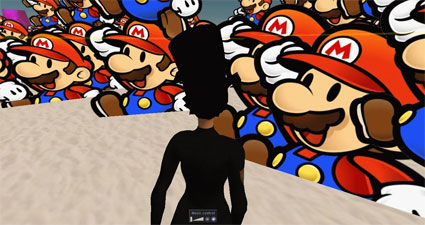
Screenshot of the Grey Goo performance
Like everyone, i had read times and times again how SL residents actions inside the synthetic world impact on their daily life, how one can make a living there, how businesses and organizations were rushing to get a space inside the online gaming platform but yesterday was the first time i could feel SL’s tangible effect on my life: i had bought a train ticket to Brescia (only 50 minutes from Milan). There, the Fabio Paris Gallery is dedicating a solo show to Gazira. I couldn’t think of a better place to get to know her work with more depth. Yeah! don’t smirk, please. I know i could do all that online but i’m old school. Still, i can’t believe i took the train to see the work of an artist who was born only two years ago.
An old entry of mine (The Second Life code performer) and a beautiful text by Domenico Quaranta will tell you all you need to know about what she does. I’ll just move to what i saw in Brussels and Brescia.
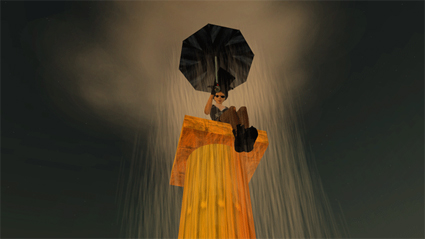
Saint Gaz’ Stylite – The Second Temptation, video still
The Brussels exhibition shows one of the episodes of Gaz of the Desert , a 23 minute movie which might very well be the first high definition movie entirely shot within a virtual world. Gaz of the Desert is inspired by Luis Buñuel‘s 1965 movie Simón del desierto (Simon of the Desert) which focused on St. Simon Stylites, a 4th century religious man who climbed on a column to be nearer to God and stayed there during thirty seven years preaching Christianity to passersby. If you were already taking for granted the fact that the virtual merges with the real, Gazira’s machinima messes with your algebra by adding surrealism to the operation. The artist takes you on a rollercoaster ride which will drive you from dream to nightmare with the elegance of Buñuel, a Persian carpet, rows of call center employees, and a motorcycle killer. The movie is online.
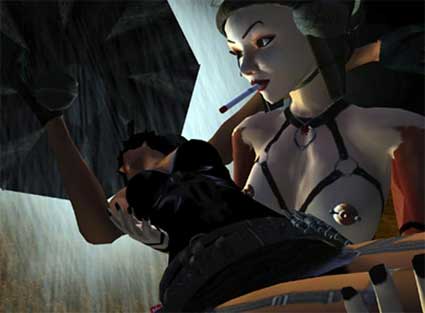
Gazira Babeli. Gaz Of The Desert – Pieta, 2007. Lambda print. 70 x 107 cm. Edition of 3. Collection Marchina-Ghizzardi, Brescia / Courtesy Fabio Paris Art Gallery, Brescia
In Brescia, there are several projects by Gazira. There’s also Anna Magnani, an Italian actress everybody remembers as ‘Pina’ in Roberto Rossellini’s neorealist masterpiece Roma, Cittá Aperta (Rome, Open City). Now Magnani was famous for that very Italian characteristic of constantly moving her hands and the expression of her face while talking. Gazira gave the actress‘ name to another video where the avatar gesticulates and where all kinds of expressions seem to fight and take power over her face.
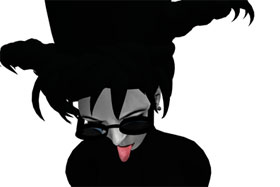 For people like me who wear their lack of knowledge about SL on their sleeve with some kind of pride this might not seem much but the making of the video actually required some coding skills. In the virtual realm any gesture is the result of a script. Anna Magnani is thus more than a video, it is also (as the catalog, Gazira Babeli explains) a script that forces the avatar to perform all the animations present in his or her inventory, in random order, one after the other.
For people like me who wear their lack of knowledge about SL on their sleeve with some kind of pride this might not seem much but the making of the video actually required some coding skills. In the virtual realm any gesture is the result of a script. Anna Magnani is thus more than a video, it is also (as the catalog, Gazira Babeli explains) a script that forces the avatar to perform all the animations present in his or her inventory, in random order, one after the other.
If Gazira is Saint Simon, i’ve had my epiphany the other day in rainy Brussels: Miss Babeli is like Anna Magnani, she’s not beautiful, she’s better than that.
Gazira Babeli’s work is on view at the Fabio Paris gallery in Brescia and at iMAL in Brussels until April 30, 2008.
Today people will look down on you if your art space doesn’t have an exhibition dedicated to ecological issues on its agenda. Unsurprisingly, Milan still hasn’t organized anything worth mentioning but her little neighbour, the enlightened and chilly Turin, did. The show is called Greenwashing. Environment, Perils, Promises and Perplexities and is on view at the Fondazione Rebaudengo until May 11, 2008.
Here’s the premise: The diverse practices represented in the exhibition do not just point the finger at the degradation of our planet, they also make more tangible the contradictions and responsibilities that we encounter personally and as a society. Art here does not necessarily proclaim a ‘correct’ ethical or green choice, but allows the possibility for broadening and analysing our perceptions and actions.

Ettore Favini, Green is the Color of Money, 2007
The 25 artists and groups selected not only engage with emissions’ offsetting, food miles, environmental marketing, ecological footprints, and other eco-conscious issues but they also bring attention to their political and social consequences. Many of the works selected are extremely good at making environmental issues less abstract and remote from our daily reach. I’m glad i had the opportunity to see all these pieces in one go. That’s what thematic exhibitions are for, right? However, i couldn’t see much past the simple gathering of works, they have this environmental streak to keep them together but there is something missing in the curatorial vision. I don’t know the secret to curating an exhibition with a scope and breath which will go beyond the sum of all the works it gangs around but it sure is puzzling when the multiplier symbol is missing.
Still, this exhibition provides enough food for thought for people who are naive enough to believe that they can sleep soundly in their organic cotton bed linen just because they recycle glass, never print any paper unless they have no other choice and always bring their own bags to the supermarket.
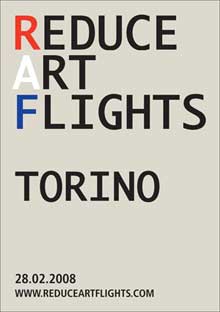 I, for one, can say proudly that i only drive bikes (i don’t have a driving license anyway) but when i saw the posters of RAF / Reduce Art Flights i could only laugh out loud at my own candor. I might not own a Hummer but i take an awful lot of planes for my work.
I, for one, can say proudly that i only drive bikes (i don’t have a driving license anyway) but when i saw the posters of RAF / Reduce Art Flights i could only laugh out loud at my own candor. I might not own a Hummer but i take an awful lot of planes for my work.
Initiated by Gustav Metzger, the RAF campaign upholds that the art world – artists, curators, critics, gallerists, collectors, museum directors, and art bloggers too i guess – could or should swap planes for less carbon dioxide-emitting transports.
The RAF acronym deliberately echoes the Royal Air Force – the aerial warfare branch of the British military – as well as the militant left-wing group known as the Red Army Faction. The message is communicated by mass-produced leaflets first distributed during Sculpture Projects M??nster last Summer. The Turin version of the leaflet is available in art galleries and inserted into international mailings in connection with the exhibition.
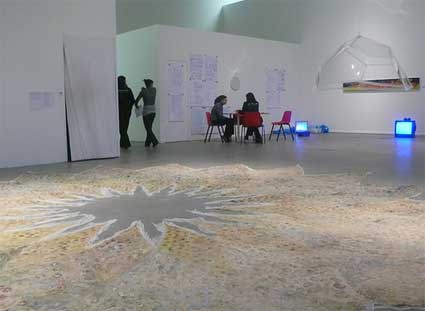
View of Beyond Pastoral (Shroud of Turin) at the Rebaudengo
BP’s environmental record is pretty appalling. In 2000, British Petroleum changed its name to BP (Beyond Petroleum) and chose a yellow and green sunflower-like as its logo in a bid to highlight its interest in alternative and environmentally friendly fuels. Nevertheless BP was named one of the “ten worst corporations” in both 2001 and 2005 based on its environmental and human rights records.
The Bruce High Quality Foundation‘s installation Beyond Pastoral (Shroud of Turin) grows out of a project that the BHQF initiated for an exhibition in New York in 2007, which consisted of a 1/5 scale model of the BP petrol station located opposite the gallery, underneath which thousands of lemons and limes were arranged in the form of the BP logo.
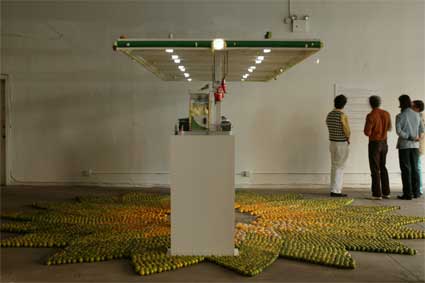
Installation in New York. Photo Oto Gillen
Each fruit was wired with electrodes and together they generated enough electrical current to illuminate the model. The irony of this seemingly earnest demonstration of an alternative energy source lies in the fact that the citruses quickly started to rot, posing a health hazard. Besides, transporting the fruit had required hundreds of liters of fuel. The Turin version of the work presented only the beautifully parched carpet of lemons and videos documenting the New York installation.
A few weeks ago, i was in a museum bar in New York and almost fell of my chair when i was served a bottle of San Pellegrino, a water that (i think) comes from Lombardy in Italy. Minerva Cuevas‘s installation in Turin echoes our absurd and eco-damaging fetishism for “exotic” waters.
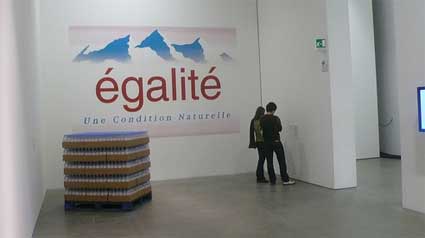
??galit?? (2003) also involves the sabotaging of a corporate graphic identity. Owned by the Danone group, Evian is probably the world’s best-known bottled water. Considering that the global market for bottled water multiplied more than 1000 times in the last decade – its average price is more than that of petrol – Cuevas has kept the shape and design of the bottle intact. Bar one detail: she replaced the familiar brand’s lettering by ??galit??, as in France’s motto, ‘Libert??, ??galit??, fraternit??’ (Liberty, equality, fraternity), subtly pointing out political issues linked to water throughout the world nowadays.
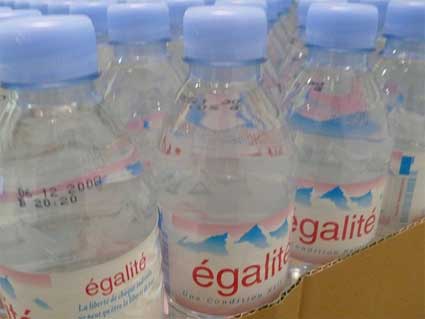
There is little equality as far as access to water is concerned, and those who have a seemingly unlimited access to it would rather pay ridiculous prices for something that comes almost freely from a tap.
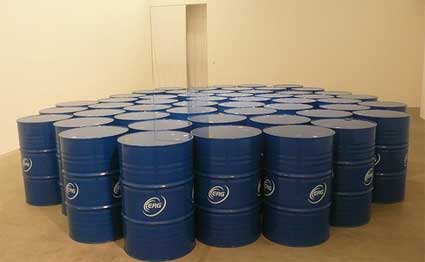
Wilfredo Prieto‘s Estanque installation is a congregation of crude oil barrels choreographed to look like an idyllic lily pond habitat complete with water puddles and a live frog (which had left the building when i visited the show).
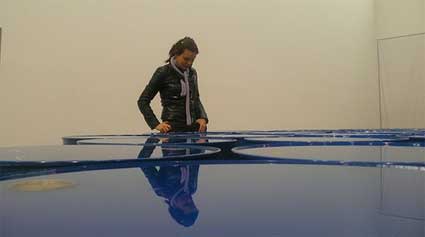
I’m the little frog on the oil pond!
Petroleum oil, which is itself an organic substance, is converted by the sheer iconic power of its container into a symbol of all of the ills of our fossil-fuel dependency. Yet the sculpture inevitably suggests the prospect of eco-advertising, as if its graphic visual summary of apparent amphibian-petroleum harmony could perfectly lend itself to an audacious company marketing department in a bid to demonstrate their ‘green’ industrial principles.
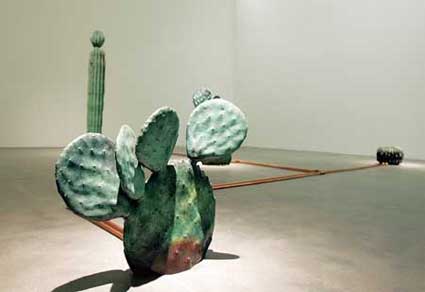
Simon Starling‘s ironic C.A.M. Crassulacean Acid Metabolism belongs to the artist’s fascinating series of “cactus works.” This installation is made of functioning cast iron radiators shaped like cacti and connected to a boiler with copper piping. The title of the work comes from a biochemical pathway that is a complex variation of photosynthesis, whereby some plants acquire carbon dioxide during the hours of darkness, minimizing thus eco-physiological stress and water loss from their leaves by avoiding gas exchange during the hot part of the day. C.A.M. opposes the supremely efficient and economical cactus strategy with the slightly ludicrous man-made radiators that expel heat into the exhibition space.
Jennifer Allora and Guillermo Calzadilla, whose life-sized clay hippopotamus had charmed me so much at the Venice Biennale in 2005, presented photos that document a participatory performance event they staged on the island of Vieques in March 2003 together with local residents and activist groups protesting against the U.S Military occupation of the island. The U.S had bought the land from the Puerto Rican government and had been using it for military exercises, and as a firing range and testing ground for bombs, missiles, and other weapons. The military experiments brought together with them severe ecological damage.
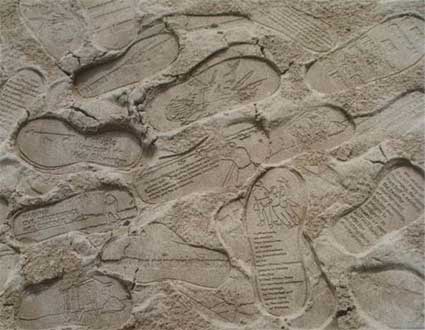
Jennifer Allora & Guillermo Calzadilla, Land Mark (Foot prints) #2, Set II, 2001-2004
Allora & Calzadilla designed rubber shoe soles to be worn during actions of protest. When activists illegally entered the bombing range, they left behind indented messages for the US military staff. The imprints were a way of reclaiming the disputed territory, giving new power to the term “landmark.”
Today the contested territory, though still contaminated and debated, is a wildlife reserve under the protection of the US Fish and Wildlife Service.
Verdict: Greenwashing is a moving exhibition worth taking the train for if you ever come to Milan this month for the Salone del Mobile. I’m sure there will be some inspiring projects and gadgets presented this year at the international furniture fair. I wonder if any of them will have the strength of most of the artworks i discovered at the Fondazione Rebaudengo the other day.
I went camera-crazy again.
GREENWASHING will run at the Fondazione Sandretto Re Rebaudengo centre for contemporary art in Turin, Italy through 11 May 2008.
Related: Book review: Worldchanging: A Users Guide for the 21st Century; Ecological Strategies in Today’s Art (part 1 and 2).
Previously at the Fondazione Re Rebaudengo: Murakami exhibition in Turin.
Image on the homepage: Amy Balkin, Public Smog, 2004.